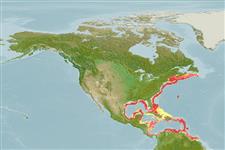>
Eupercaria/misc (Various families in series Eupercaria) >
Latilidae (Deepwater tilefishes)
Etymology: Lopholatilus: Greek, lophos = crest + Latin, latus = wide (Ref. 45335).
More on authors: Goode & Bean.
Environment: milieu / climate zone / depth range / distribution range
Écologie
marin démersal; profondeur 80 - 540 m (Ref. 5217). Subtropical; 9°C - 14°C (Ref. 33985); 46°N - 5°N, 98°W - 53°W
Western Atlantic: Nova Scotia, Canada south along the U.S., Gulf of Mexico from the Florida Keys, Tampa (Florida) to the Texas/Mexico border, and off Mexico from Tabasco to the Yucatan Peninsula, and along South America from the Gulf of Cariaco (Venezuela) to Suriname (R. Robertson and J. Dooley pers. comm. 2013).
Length at first maturity / Taille / Poids / Âge
Maturity: Lm 42.2 range ? - ? cm
Max length : 125 cm TL mâle / non sexé; (Ref. 3276); 95.0 cm FL (female); common length : 90.0 cm TL mâle / non sexé; (Ref. 3276); poids max. publié: 30.0 kg (Ref. 9988); âge max. reporté: 35 années (Ref. 6086)
Most common around 200 m, usually over mud or sand bottom and occasionally over rough bottom (Ref. 9988); prefers temperature of 8-17°C (Ref. 5951). Feeds mainly on shrimp and crabs, but also takes fish, squid, bivalves and holothurians. Sensitive to cold water (Ref. 9988), a mass die-off occurred in 1882, after which the species was rare for decades, presumably due to unusually cold water (Ref. 7251). Marketed fresh or frozen; can be steamed, pan-fried, broiled, microwaved and baked (Ref. 9988).
Dooley, J.K., 1978. Branchiostegidae. In W. Fischer (ed.) FAO species identification sheets for fishery purposes. West Atlantic (Fishing Area 31). Volume 1. FAO, Rome. (Ref. 3276)
Statut dans la liste rouge de l'IUCN (Ref. 130435)
Menace pour l'homme
Harmless
Utilisations par l'homme
Pêcheries: commercial; pêche sportive: oui
Plus d'informations
CollaborateursImagesStamps, Coins Misc.SonsCiguateraVitesseType de nageSurface branchialeOtolithesCerveauxVision
Outils
Articles particuliers
Télécharger en XML
Sources Internet
Estimates based on models
Preferred temperature (Ref.
123201): 6.6 - 22.3, mean 16.2 °C (based on 108 cells).
Phylogenetic diversity index (Ref.
82804): PD
50 = 0.7500 [Uniqueness, from 0.5 = low to 2.0 = high].
Bayesian length-weight: a=0.00776 (0.00407 - 0.01480), b=3.11 (2.93 - 3.29), in cm total length, based on LWR estimates for this species & (Sub)family-body (Ref.
93245).
Niveau trophique (Ref.
69278): 3.9 ±0.2 se; based on diet studies.
Generation time: 11.7 (7.2 - 12.8) years. Estimated as median ln(3)/K based on 10
growth studies.
Résilience (Ref.
120179): Faible, temps minimum de doublement de population : 4,5 à 14 années (K=0.09-0.13; tm=5; tmax=35; Fec=195,000).
Fishing Vulnerability (Ref.
59153): High to very high vulnerability (73 of 100).
Climate Vulnerability (Ref.
125649): Moderate vulnerability (38 of 100).
Nutrients (Ref.
124155): Calcium = 32.9 [21.7, 59.0] mg/100g; Iron = 0.78 [0.49, 1.21] mg/100g; Protein = 18.6 [16.6, 20.5] %; Omega3 = 0.359 [0.235, 0.519] g/100g; Selenium = 49.3 [26.7, 88.1] μg/100g; VitaminA = 8.24 [3.15, 21.77] μg/100g; Zinc = 0.544 [0.410, 0.758] mg/100g (wet weight);
